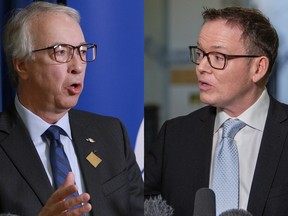Opinion: Right-of-centre co-operation has been a feature of B.C. politics, but it’ll likely take another NDP win to get it going this time

Article content
VICTORIA — Recent B.C. opinion polls tell a similar story as an election approaches.
The New Democrats are comfortably in first place with support in the range of 40 to 42 per cent. Yet support for the B.C. Conservative and B.C. United parties could turn the election into a dead heat if it were somehow added together into votes for a single party.
Article content
When I was asked recently how supporters of the two parties could be persuaded to get together, I replied, only half-jokingly, “have you considered math lessons?”
Advertisement 2
Article content
The notion of parties combining forces to defeat the NDP is easy to suggest, harder to accomplish.
Still, it has been done. And the only two examples in modern times did not go the route suggested lately, namely by the merger of two existing parties.
In 1972, the New Democrats won a majority of seats with just under 40 per cent of the popular vote. Three parties — Social Credit, Conservatives, Liberals — split the balance of 60 per cent.
The NDP government’s transformative agenda — including innovations like the agricultural land reserve, pharmacare and ICBC that survive to this day — provoked calls for the creation of a single “majority movement” to hold the government to a single term.
What emerged was a revitalized version of Social Credit, led by Bill Bennett, whose father had governed B.C. from the 1950s to the 1970s. Liberals and Conservatives abandoned their parties and took out Socred memberships.
This was not done out of love of Social Credit. Liberal MLA Pat McGeer had written an entire book denouncing the party.
But he and others recognized that Social Credit had the resources, momentum and broad base of support around the province. It was the best bet to halt a government that had gone too far too fast.
Article content
Advertisement 3
Article content
As proved to be the case when NDP Premier Dave Barrett called a snap election in 1975.
The New Democrats got about the same share of the vote as they had three years earlier. But they were crushed in the seat count by the revitalized Bennett-led Socreds, who took almost 50 per cent of the votes. The party went on to consign the NDP to the Opposition benches for three more elections.
The New Democrats returned to power under Mike Harcourt in 1991, again with support in the 40 per cent range. The non-NDP share was split between the remnants of a deeply discredited Social Credit and a B.C. Liberal party that surged from nowhere to second place.
This time it took the better part of a decade for the anti-NDP vote to coalesce under a single party. The continued fractiousness on the centre-right allowed the New Democrats to win another majority with just under 40 per cent of the vote in 1996.
The B.C. Liberals, who took more votes but fewer seats than the NDP in 1996, did over the next few years become the party of choice for those who wanted to deny the NDP a third term.
The Liberals won a record majority in 2001 and defeated the NDP in three more elections before losing their legislative majority in a squeaker (less than 200 votes in one riding) in 2017.
Advertisement 4
Article content
The New Democrats, who took power with the support of the Greens in 2017, then won a huge majority in a snap election in 2020, are today polling well ahead the B.C. Conservatives and B.C. United.
Neither the Conservatives nor B.C. United are in the dominant position that Social Credit occupied in the mid-70s or the B.C. Liberals in the late 90s.
The B.C. Conservatives have a growing lead in the polls. Their recognizable brand is boosted by its association with the Pierre Poilievre-led federal party of the same name.
But under the party leader, John Rustad, the Conservatives are unproven and inexperienced. They have had to weed out two extreme candidates and may have to rein in others.
B.C. United has the most seats and resources. It did an effective job holding the government to account as the Opposition during the recent session of the legislature.
But the party leader, Kevin Falcon, has made major mistakes.
He insisted on changing the party name without the necessary resources for an immediate rebranding campaign.
He forced out Rustad for no good reason, then failed to treat him with respect when the Conservatives surged in the opinion polls.
Advertisement 5
Article content
Even if there were a precedent for a merger between the parties, there’s not enough time to make the necessary organizational and legal changes. Some nominated candidates would have to withdraw. Money raised by one party cannot simply be transferred to another.
Besides, there is no inclination for a merger or even much basis for co-operation.
Rustad says, “We’re not going to be running anything less than 93 candidates under the Conservative banner.” Falcon says, “They’ve got some pretty extreme candidates. We don’t want to work with those kinds of candidates.”
In the 1970s, it took one term of NDP government for its opponents to assemble the one party that defeated the NDP. In the 1990s, it was two terms. The way things are going today, it will take at least three.
Recommended from Editorial
Bookmark our website and support our journalism: Don’t miss the news you need to know — add VancouverSun.com and TheProvince.com to your bookmarks and sign up for our newsletters here.
You can also support our journalism by becoming a digital subscriber: For just $14 a month, you can get unlimited access to The Vancouver Sun, The Province, National Post and 13 other Canadian news sites. Support us by subscribing today: The Vancouver Sun | The Province.
Article content






